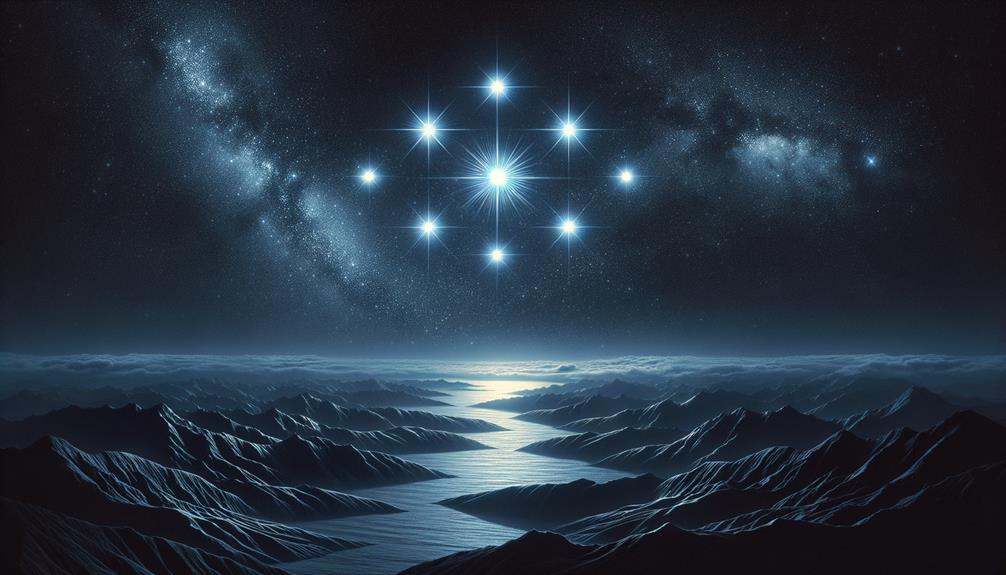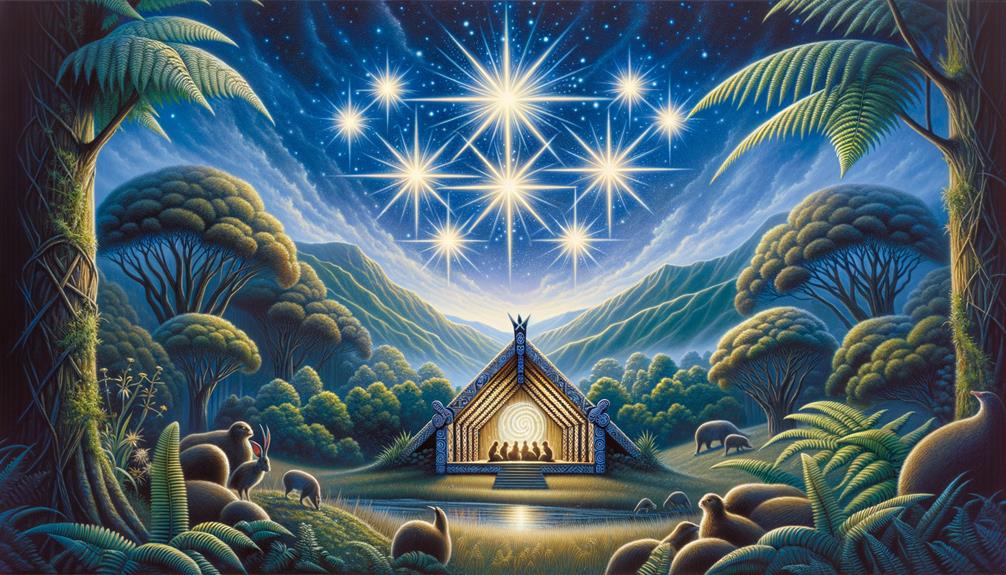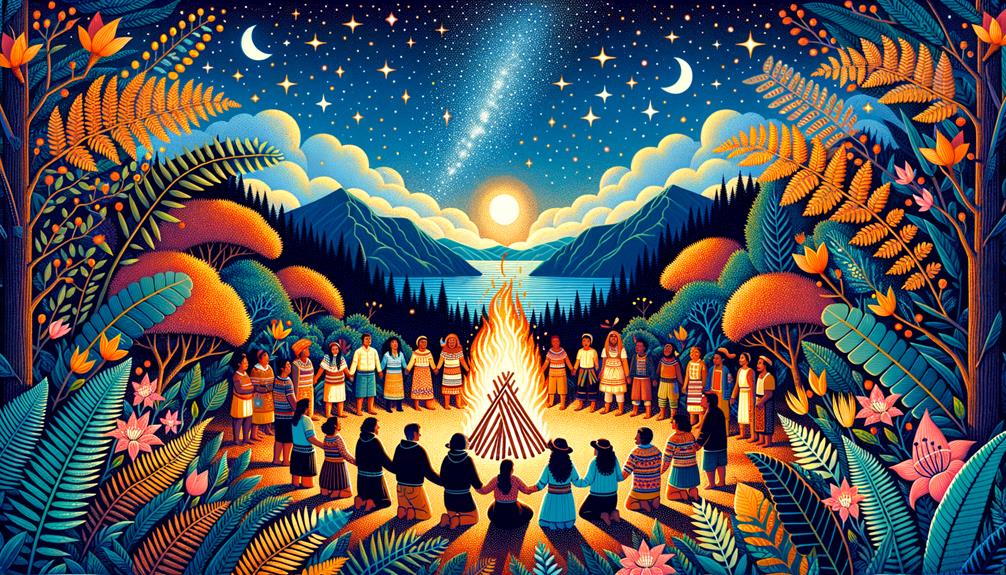The Matariki stars hold a special place for me. They mark the Maori New Year and serve as a source of renewal and fresh beginnings. There are nine of them, each bearing its own distinct message. Take Tupu-ā-rangi and Tupu-ā-nuku, for example, they both signify abundance. They help guide me in understanding when it's time to sow seeds or harvest crops. Matariki is a way for me to respect the cycle of life, fostering a deeper connection with nature and my community. There's a timeless wisdom attached to Matariki, one that brings about change. Can you imagine it? On a crisp winter's night, the Matariki stars appear, encouraging us to start anew. This is an invitation into the rich world of Maori cosmology. Are you intrigued by the stars?
Understanding Matariki Significance
If you want to really get the importance of Matariki, you need to dive into the fascinating world of Māori culture. That's where you'll find out that these stars are actually a signal that it's time to start a new cycle of planting and harvesting. Matariki is a group of stars that marks the Māori New Year, a season of celebration and fresh starts. This is when growing food and the patterns of nature become the main focus.
The stars Tupu-ā-rangi and Tupu-ā-nuku play a key role in this yearly cycle. They're linked to food and medicine and they represent the heavenly and earthly abundance, showing how the sky and the earth are connected in Māori culture. The brightness of these stars when they rise can even give you a hint about the weather, helping you predict the best conditions for planting in the months ahead.
The Maramataka, a traditional Māori lunar calendar, helps manage all these activities. It's in sync with the lunar months, making it easier to figure out the best time for fishing, gardening, and planting. This calendar shows how deeply the Māori understand and respect nature. However, it varies from region to region and tribe to tribe, showing the wonderful diversity of Māori culture. Each community celebrates in its own way, tailoring the festivities to its own needs and traditions.
The Nine Matariki Stars

We've spent some time talking about Tupu-ā-rangi and Tupu-ā-nuku during the Māori New Year. But did you know that they are just part of a larger group of nine stars known as Matariki? Each star has its own special place and meaning in Māori culture. The stars of Matariki are like bright sparks in the winter sky, helping us to understand and connect with the world around us.
So, let's take a closer look at these nine stars. Have you heard of Pōhutukawa? This star helps us remember our family and friends who are no longer with us. Tupuānuku and Tupuārangi are all about food. They remind us of all the delicious things we can find on the land and in the sky. Waitī and Waitā represent our rivers and oceans, showing us how everything in life is connected. Waipuna-ā-rangi is linked to rain, something we all need to live.
Then there's Ururangi, the wind star. This one lets us know what the weather's going to be like in the coming year. Hiwa-i-te-rangi is a bit like a wish star. It symbolizes our dreams and goals, pointing us towards the future. Last but not least, there's Matariki. She's like a kind mother, looking after us and helping us to feel good.
These stars are like a map for the Māori New Year, helping us to think about the past, present, and future. They encourage us to reflect on our lives, make positive changes, and aim for our dreams.
Matariki in Maori Culture

Matariki holds an irreplaceable spot in the vibrant Maori culture. It is a time of renewal that links old traditions, sky watching, and a profound respect for ancestors. When the Matariki star cluster, also known as Pleiades, appears, it signifies the Māori New Year and the beginning of the First Lunar Month. This period is not only for happiness, but also reflection, a moment to commemorate those who've made their journey to Te Rerenga Wairua.
Our ancestors, guided by Tohunga kōkōrangi, the original Māori astronomers, would gaze at the stars to make sense of their surroundings. Rangi Mātāmua, a respected Māori astronomer, carries on this tradition today. He imparts the knowledge that each star in Te iwa o Matariki carries its own unique significance, associated with elements of our environment like farming, food resources, and freshwater bodies.
Matariki's celebration isn't just a one-time event. It's a sequence of related customs and gatherings that last a month. It's a period for us to reinforce our connection to nature and each other. Te Papa, our national museum, presents exhibits that help us understand the deep importance of Matariki in Māori culture. It's a chance to delve deeper, to truly comprehend the impact of this astronomical event.
Celebrating Matariki Traditionally

Matariki festivities, traditionally celebrated by the Māori people, are heartfelt occasions that light a spark in our collective soul. We gather around blazing fires, paying homage to the Matariki stars, and indulge in hearty meals with our dear ones, all the while remembering those who are no longer with us. These customs, timed with the Māori lunar calendar, resonate with the spirit of nostalgia, prosperity, and an enduring bond with the land.
| Traditional Celebrations | What They Mean |
|---|---|
| :-: | :-: |
| Making fires | Represents the warmth, light, and a tribute to the heavenly bodies |
| Offering food | Symbolizes plenty, appreciation, and generosity |
| Observing the stars | Connects us to the cosmos, inspires wonder, and conveys cultural wisdom |
| Remembering those passed on | Expresses deep respect for ancestors, nurturing a sense of continuity |
| Enjoying meals together | Enhances relationships, builds community, and is a celebration of life |
These aren't just formal ceremonies; they're a lively display of cultural wisdom, reflecting the Māori's deep reverence for nature and the celestial bodies. Looking at the Matariki stars, we're not just bystanders, but engaged in an age-old cycle of rebirth. So, let's value these traditional practices, as they provide us a way to recall our beginnings, rejoice in prosperity, and fortify our bond with the earth and each other.
Modern Matariki Observances

In today's world, Matariki celebrations continue to evolve. They're marked with lively local events, artistic displays, and cultural performances that offer a fresh perspective on ancient customs. Our museums, galleries, and libraries transform into places where stories unfold, presenting workshops that pay homage to Māori heritage and the importance of the star cluster. Community get-togethers, filled with traditional knowledge, serve as a stage for exchanging stories and wisdom, demonstrating the Māori culture's strength and adaptability.
Matariki has also found its way into the New Zealand school curriculum, where activities are designed to nurture an appreciation for Māori customs and traditions. Kids get to learn about Māori folklore, participate in art projects, and perform in shows, which helps to strengthen their cultural ties and understanding.
At the same time, businesses are acknowledging the significance of this heritage celebration and are offering special promotions that highlight Māori customs. These initiatives not only stimulate local economies but also help to highlight the voices of the Māori, emphasizing their role in shaping New Zealand's cultural landscape.
Today's Matariki celebrations act as a guide, leading us towards a deeper comprehension of Māori culture. It's a period of renewal, and an opportunity to pay homage to the past while confidently moving towards the future.
Frequently Asked Questions
What Are the 7 Stars of Matariki Called?
People often inquire about the names of the seven stars of Matariki. They go by the names of Matariki, Pōhutukawa, Tupuānuku, Tupuārangi, Waitī, Waitā, and Waipuna-ā-rangi. Each star has its own unique importance, offering us guidance in matters of health, memory, and our connection with the natural world.
What Do the 9 Matariki Stars Represent?
You know, I've always been fascinated by the nine Matariki stars. They're not just pretty lights in the sky, they actually represent different aspects of our lives. For example, some stars represent earth, others symbolize the sky, and there are even a couple that stand for fresh and salt water. And the coolest part? They also represent remembrance, guiding us in times of harvesting, cultivation, and when we're paying tribute to our history. It's like a celestial compass, if you think about it.
What Is Matariki the Stars of the Year?
'In our Maori traditions, Matariki holds a special place as the Stars of the Year. It welcomes the New Year and serves as our guide to the cycles of planting. It's almost like a celestial roadmap, if you will, leading us to periods of growth and renewal. Essentially, it's a key part of our life's journey.'
What Does Matariki Mean in English?
If you're curious about what 'Matariki' means in English, it's actually quite fascinating. This Maori term is often translated as 'eyes of god' or 'little eyes'. It's a reference to the Pleiades star cluster, which is a beautiful and captivating sight to behold in the night sky. The term also holds a deep connection to the Seven Sisters constellation, further enriching its cultural and astronomical importance. So, when you gaze up at the stars and spot the Pleiades, you can think of it as looking into the 'eyes of god'.


